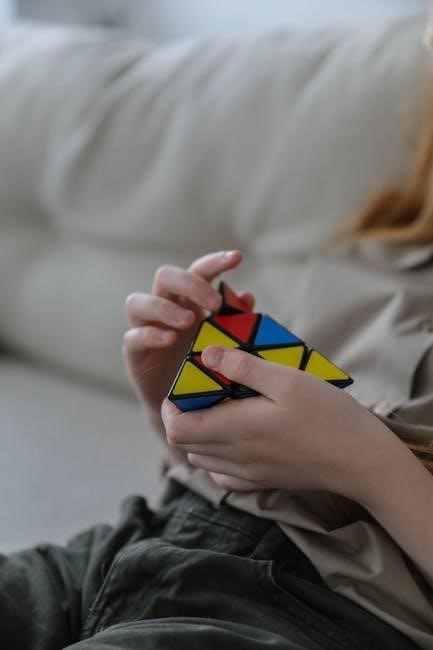The 4×4 Rubik’s Cube solution involves the reduction method‚ focusing on solving centers‚ pairing edges‚ and transitioning to a 3×3 solve. This guide provides a step-by-step approach to mastering the Rubik’s Revenge.
1.1. Overview of the 4×4 Cube
The 4×4 Rubik’s Cube‚ also known as Rubik’s Revenge‚ is a larger and more complex version of the classic 3×3 puzzle. It consists of 8 corner pieces‚ 24 edge pieces‚ and 24 center pieces. Unlike the 3×3 cube‚ the 4×4 does not have fixed center pieces‚ making it more challenging. The cube can be solved using methods like the reduction method‚ which involves grouping centers‚ pairing edges‚ and reducing the cube to a 3×3 stage. This method is widely used by speedcubers and is detailed in various PDF guides and online tutorials‚ making it accessible for learners of all levels.
1.2. Importance of Understanding the 3×3 Cube First
Mastering the 3×3 Rubik’s Cube is essential before attempting the 4×4. The 4×4 solution builds on the same fundamental concepts‚ such as understanding cube notation‚ layer-by-layer solving‚ and basic algorithms. Familiarity with the 3×3 allows for an easier transition to the 4×4‚ as many of the same principles apply‚ like solving centers‚ edges‚ and corners. Without a solid grasp of the 3×3‚ the additional complexity of the 4×4—such as paired edges and parity issues—can become overwhelming. PDF guides and tutorials often assume prior knowledge of the 3×3‚ making it a crucial starting point for any aspiring 4×4 solver.

1.3. Key Differences Between 3×3 and 4×4 Solving Methods
The 4×4 Rubik’s Cube introduces several unique challenges compared to the 3×3. Unlike the 3×3‚ the 4×4 lacks fixed centers‚ requiring solvers to first form and orient the centers manually. Additionally‚ the 4×4 involves pairing edges‚ which must be done carefully to maintain even distribution. Another significant difference is the potential for parity issues‚ which do not occur in the 3×3. These challenges make the 4×4 more complex‚ but PDF guides and online tutorials provide detailed strategies to overcome them. Understanding these differences is crucial for adapting 3×3 techniques to the 4×4‚ ensuring a smoother learning process.

The Reduction Method for Solving the 4×4 Cube
The reduction method simplifies the 4×4 cube by solving centers‚ pairing edges‚ and reducing it to a 3×3 solvable state‚ addressing parity issues as needed.
2.1; Solving the Centers
Solving the centers involves creating a 2×2 block of the same color on each face. Start with one color‚ like white‚ and align the center pieces by twisting the outer layers. Use slice moves to adjust without disturbing already placed pieces. Focus on one face at a time‚ ensuring all four center pieces match. This step requires patience and attention to detail to achieve uniform centers‚ which are crucial for the subsequent steps in solving the 4×4 cube effectively.
2.2. Pairing the Edges
After solving the centers‚ the next step is pairing the edges. This involves matching each edge piece with its corresponding partner to form a complete pair. Use slice moves to align edges without disturbing the centers. Focus on one pair at a time‚ ensuring they are correctly oriented and positioned. Once paired‚ lock them in place by twisting the outer layers. Repeat this process for all edges‚ maintaining the solved centers throughout. Edge pairing requires precision and strategy to avoid disrupting previously solved pieces‚ making it a critical step in the reduction method for the 4×4 cube.
2.3. Solving the 3×3 Stage
Once the centers are solved and edges are paired‚ the cube is reduced to a 3×3-like state. Treat the remaining pieces as if solving a standard 3×3 Rubik’s Cube‚ focusing on orienting and permuting the corners and edges. However‚ the 4×4 cube introduces unique challenges‚ such as no fixed center pieces and potential parity issues. Use standard 3×3 algorithms to solve the remaining layers‚ ensuring the cube’s integrity by avoiding moves that disrupt the already paired edges. This stage requires precision and adaptability to address any parity errors that arise‚ ensuring a smooth transition to the final solved state.
2.4. Addressing Parity Issues
Parity issues are common in 4×4 Rubik’s Cube solving‚ arising due to the even number of pieces. These issues include edge and corner parity‚ where pieces may be misaligned or flipped. Edge parity occurs when edges cannot be paired correctly‚ while corner parity involves incorrect corner orientations. Specific algorithms are used to resolve these issues without disturbing already solved sections. Understanding and addressing parity is crucial for completing the cube‚ as ignoring these errors can lead to unsolvable configurations. These algorithms correct the alignment and orientation of pieces‚ ensuring the cube can be fully solved. This step is essential for achieving a solved state.

Step-by-Step Guide to Solving the 4×4 Cube
This guide outlines solving the 4×4 cube in four main steps: solving centers‚ pairing edges‚ solving the 3×3 stage‚ and addressing parity issues for a complete solution.
3.1. Step 1: Solving the Centers
Solving the centers is the first step in mastering the 4×4 Rubik’s Cube. Unlike the 3×3 cube‚ the 4×4 has no fixed centers‚ so you must form them manually. Hold the cube and focus on one face‚ ensuring all center pieces match the color of that face. Rotate the outer layers to align the center stickers. If a center piece is misaligned‚ use algorithms to correct it without disturbing other solved centers. Repeat this process for all six faces. This step requires patience‚ as forming the centers correctly sets the foundation for the rest of the solve. Practice makes perfect!
3.2. Step 2: Pairing the Edges
After solving the centers‚ the next step is to pair the edges. Hold the cube with solved centers on top and bottom. Locate an edge piece without its pair and twist the outer layers to align it with its match. Use algorithms to move edges without disturbing the centers. Repeat this process for all edges‚ ensuring each pair is correctly aligned. As you progress‚ fewer edges will remain unpaired‚ simplifying the task. Patience is key‚ as edge pairing can be challenging but is essential for transitioning to the 3×3 stage. Proper edge alignment ensures a smoother solve in subsequent steps.
3.3. Step 3: Solving the 3×3 Stage
With centers solved and edges paired‚ the cube can now be treated like a 3×3. Focus on solving the remaining corners and edges using standard 3×3 algorithms. Ensure each face is correctly oriented and aligned. Address any parity issues that arise‚ such as flipped edges or corners‚ using specific parity algorithms. Maintain the solved state of the centers and edges while working on the final layers. Once all pieces are in place‚ double-check the cube to ensure there are no remaining errors. This stage requires precision and attention to detail to achieve a fully solved 4×4 cube.
3.4. Step 4: Resolving Parity
Parity issues are common in 4×4 solving and occur when edges or corners are misaligned. These include flipped edges or corners that don’t match their respective centers. To resolve parity‚ use specific algorithms like the “4-cycle” or “T-perm‚” which correct edge orientation without disrupting solved pieces. Ensure all edges are paired correctly before addressing corner parity. If a single pair of edges is flipped‚ execute the edge-flipping algorithm. For corner parity‚ apply the corner-orienting algorithm to align the final pieces. Properly resolving parity ensures all pieces align‚ leading to a fully solved cube. This step requires careful execution to maintain the solved state of earlier stages.

Advanced Techniques for the 4×4 Cube
Advanced techniques include optimized edge pairing‚ efficient parity resolution‚ and speedcubing strategies. These methods refine your solving process‚ reducing time and improving overall performance.
4.1. Edge Pairing Strategies
Edge pairing strategies are crucial for efficient 4×4 solving. Techniques like “edge pairing without swapping” and “cycle-breaking algorithms” help maintain cube structure. Advanced pairings minimize moves‚ enhancing speed and accuracy. Properly aligned edges reduce parity issues‚ streamlining the 3×3 stage. Mastering these strategies ensures faster‚ cleaner solves.
4.2. Advanced Parity Resolution
Advanced parity resolution is essential for mastering the 4×4 cube. Unlike the 3×3‚ the 4×4 often encounters parity issues during the solving process. These include edge and corner parity‚ which require specific algorithms to resolve without disrupting the cube’s structure. Techniques like the “T-Perm” and “Y-Perm” are commonly used to address these issues. Additionally‚ the Yau method incorporates strategies to minimize parity occurrences by solving centers and the cross first. Practitioners must learn to identify and apply the correct algorithms efficiently‚ ensuring minimal move count and maintaining cube integrity. Proper parity resolution is a cornerstone of competitive speedcubing and advanced solving methods.
4.3. Optimizing Your Solve Time
Optimizing solve time on the 4×4 Rubik’s Cube requires a combination of efficient techniques and consistent practice. One key strategy is to improve finger independence and dexterity‚ allowing for faster and more precise movements. Additionally‚ learning to “look ahead” while solving can significantly reduce pauses‚ as it enables anticipation of the next steps. Practicing algorithms for edge pairing and parity resolution can also streamline the solving process. Regularly timing solves and analyzing performance helps identify bottlenecks. Incorporating advanced methods like the Yau or M2 into your routine can further enhance speed. Consistent practice and adaptation of techniques are essential for achieving faster solve times.

The Yau Method for 4×4 Solving
The Yau Method‚ introduced by Robert Yau‚ is a popular speedcubing technique for the 4×4 cube. It involves solving centers and the cross before pairing edges‚ optimizing efficiency.
The Yau Method‚ developed by Robert Yau in 2009‚ is a highly efficient approach for solving the 4×4 Rubik’s Cube. It is particularly favored by speedcubers due to its streamlined process. Unlike the reduction method‚ the Yau Method involves solving the centers and the cross simultaneously before pairing the edges. This approach minimizes the number of moves required‚ making it ideal for competitive solving. The method is structured to maintain orientation and reduce the likelihood of parity issues‚ ensuring a faster and more consistent solve. Its simplicity and efficiency have made it a cornerstone of modern 4×4 speedcubing techniques.
5.2. Solving Centers and Cross
The Yau Method begins with solving the centers and cross. Since the 4×4 cube lacks fixed centers‚ you must first form them by pairing edge pieces of the same color. This step requires careful alignment and may involve multiple moves to ensure correct orientation. Once the centers are established‚ focus on solving the cross‚ similar to the 3×3 method. Maintain the orientation of the cross throughout to avoid complications in later steps. This phase sets the foundation for the rest of the solve‚ ensuring a smooth transition to edge pairing and the final 3×3 stage. Precision is key for efficiency.
5.3. Pairing Edges in the Yau Method
In the Yau Method‚ edge pairing follows solving the centers and cross. Focus on aligning matching edge pairs without disrupting the solved centers. Use slice moves to pair edges while maintaining the cross. Ensure each edge pair is correctly oriented relative to its center. This step requires precision to avoid misalignment. Once edges are paired‚ the cube transitions smoothly to the 3×3 stage. Efficient edge pairing is crucial for minimizing total move count‚ making it a key skill for speedcubers aiming to optimize their solves. Proper execution here sets the stage for a successful finalization of the 3×3 configuration.
5.4. Finalizing the 3×3 Stage
After pairing the edges‚ the final step in the Yau Method involves solving the remaining 3×3 configuration. Focus on orienting and permuting the last layer corners and edges using standard 3×3 algorithms. Ensure the centers remain solved throughout this process. Address any remaining orientation issues with corner and edge flips. Once the top layer is solved‚ double-check the cube for any misaligned pieces. This stage requires attention to detail to ensure all pieces are correctly positioned and oriented. Proper execution here completes the solve‚ leaving the cube fully resolved and ready for faster solving with practice.

Speedcubing and Competition Techniques
Speedcubing involves mastering advanced techniques‚ efficient algorithms‚ and optimal finger tricks. Top speedcubers use refined methods to achieve record times‚ with resources like PDF guides aiding improvement.
Speedcubing is the competitive practice of solving Rubik’s Cubes as quickly as possible. For 4×4 cubes‚ this involves mastering advanced techniques‚ efficient algorithms‚ and optimal finger tricks. Competitive speedcubers focus on reducing solve times through consistent practice and understanding of cube mechanics. The 4×4 cube‚ known as the Rubik’s Revenge‚ presents unique challenges due to its larger size and additional layers. Speedcubers often use refined methods like the Yau or Reduction techniques to achieve record times. Resources such as PDF guides and online tutorials provide detailed algorithms and strategies to improve efficiency. Dedication and practice are key to progressing from beginner to advanced speedcubing levels.
6.2. Advanced Algorithms for Speed
Advanced algorithms for speedcubing the 4×4 cube focus on optimizing efficiency and reducing solve times. Techniques like the Yau method emphasize solving centers and edges simultaneously‚ while the reduction method breaks the cube into manageable 3×3 stages. Edge pairing and parity resolution are critical‚ requiring precise algorithms to maintain speed. These methods minimize unnecessary moves and leverage finger tricks for faster execution. By mastering these advanced strategies‚ cubers can significantly improve their performance in competitions. Regular practice and consistency are essential to internalize these algorithms and achieve record-breaking times. Advanced speedcubing relies on both technical skill and mental agility to execute complex sequences flawlessly.
6.3. Notable Speedcubers and Their Methods
Notable speedcubers like Matt Pidden and Oliver Frost have revolutionized 4×4 solving with their innovative methods. Matt Pidden broke the world record by solving the 4×4 cube in under 30 seconds‚ showcasing his advanced algorithms and finger tricks. Oliver Frost‚ known for blindfolded solving‚ demonstrated exceptional memory and technique. Their methods emphasize efficiency‚ focusing on reducing unnecessary moves and optimizing parity resolution. These speedcubers inspire the community by sharing their strategies‚ such as the Yau method and reduction techniques‚ which have become standard in competitive solving. Their contributions have significantly advanced the art of speedcubing‚ pushing the limits of what is possible with the 4×4 cube.

Resources for Learning and Mastery
Access detailed PDF guides‚ online tutorials‚ and video lessons for mastering the 4×4 cube. Join communities like Reddit’s r/learnrubiks and Speedsolving for support and advanced techniques.
7.1. Best PDF Guides for 4×4 Solving
Premium PDF guides like the “Rubik’s Master Solution Guide” and “4x4x4 Cubes Manual” offer comprehensive instructions. These documents detail center solving‚ edge pairing‚ and 3×3 stage techniques‚ ideal for both beginners and advanced solvers. They include algorithms‚ step-by-step methods‚ and troubleshooting tips. Websites like cubeskills.com provide free downloadable PDFs with visual aids and detailed explanations‚ making them essential resources for mastering the 4×4 cube. These guides are easily accessible and serve as valuable tools for improving solving speed and understanding complex parity issues.
7.2. Online Tutorials and Videos
Online tutorials and videos are invaluable for mastering the 4×4 Rubik’s Cube. Platforms like YouTube offer detailed step-by-step guides‚ such as the reduction method and Yau method. Channels like Cubeskills and J Perm provide high-quality tutorials‚ breaking down complex steps into manageable parts. Video tutorials allow learners to visualize algorithms and techniques in real-time‚ making it easier to follow along. Many speedcubers share their advanced methods and tips‚ catering to both beginners and experienced solvers. These resources are often free and accessible‚ making them a popular choice for improving skills and understanding parity resolution. They complement PDF guides perfectly for a well-rounded learning experience.
7.3. Community and Forums for Support
Engaging with the Rubik’s Cube community and forums provides invaluable support for learners. Platforms like Reddit’s r/learnrubiks and specialized cubing forums offer spaces to ask questions‚ share progress‚ and learn from experienced solvers. Many communities host challenges and events to motivate improvement. Veteran cubers often share tips and resources‚ helping newcomers overcome common obstacles. These interactions foster a sense of camaraderie and encourage consistent practice. Additionally‚ community feedback can refine techniques and address specific issues‚ making the learning journey more enjoyable and effective; Active participation can significantly accelerate mastery of the 4×4 cube.

Common Mistakes and Troubleshooting
Common mistakes include misaligning centers‚ incorrect edge pairing‚ and unresolved parity issues. Troubleshooting involves revisiting steps‚ ensuring proper alignment‚ and applying parity fixes to restore cube solvability.
8.1. Mistakes in Center Solving
A common mistake is misaligning or mismatching center colors. Ensure each center is uniformly colored and aligned properly. Use slice moves to adjust centers without disturbing edges. Avoid rushing through center solving‚ as this can lead to edge pairing issues and parity problems later. Double-check each center’s alignment before proceeding to edge pairing. If centers are misaligned‚ correct them by twisting the appropriate slice. Practice meticulous center solving to build a solid foundation for the rest of the cube. Remember‚ accurate center alignment is crucial for achieving a smooth and error-free solve.
8;2. Common Edge Pairing Errors
One common mistake during edge pairing is incorrectly aligning edges with centers‚ leading to mismatched colors. Another error is swapping or misplacing edges‚ causing parity issues later. Ensure edges are paired without disrupting solved centers. Avoid using slice moves that affect already paired edges. If edges are mispaired‚ correct them before proceeding to the 3×3 stage. Double-check each edge pair’s alignment and color consistency. Practice careful observation to avoid these errors‚ as they can complicate the solve significantly. Correcting edge pairing mistakes early prevents time-consuming fixes later in the process.
8.3. Troubleshooting Parity Issues
Parity issues on a 4×4 cube often arise during the 3×3 stage‚ causing misalignment of edges or corners. These are usually due to incorrect edge pairing or slice moves. Identify the type of parity: edge parity (swapped edges) or corner parity (twisted corners). Use specific algorithms to resolve these issues without disrupting solved pieces. For edge parity‚ apply the “T” or “Y” algorithms. For corner parity‚ use the “R” or “L” slice twists. Ensure all edge pairs are correctly aligned before entering the 3×3 stage. Regular practice helps minimize parity errors‚ and mastering troubleshooting techniques ensures smoother solves.

Practice and Mastery Tips
Regular practice‚ setting achievable goals‚ and analyzing solve times are crucial. Focus on refining techniques‚ learning advanced methods‚ and staying persistent to master the 4×4 cube.
9.1. Setting Goals for Improvement
Setting specific‚ achievable goals is essential for mastering the 4×4 Rubik’s Cube. Start by breaking the learning process into manageable steps‚ such as solving centers‚ pairing edges‚ and resolving parity. Use guides like the reduction or Yau method to track progress. Aim to reduce solve times gradually while maintaining accuracy. Regular practice and consistent effort are key to improvement. Celebrate small milestones‚ like mastering a new algorithm or completing a stage flawlessly‚ to stay motivated. Tracking progress through solve times and error reduction helps refine techniques and build confidence.
9.2. Effective Practice Routines
Consistent practice is key to mastering the 4×4 Rubik’s Cube. Dedicate daily time to solve the cube‚ focusing on specific stages like centers‚ edges‚ or parity resolution. Start with short sessions‚ gradually increasing duration as skills improve. Use online timers to track solve times and identify areas for optimization. Incorporate speedcubing algorithms to enhance efficiency and accuracy. Practice blind solving techniques to improve muscle memory. Regularly review PDF guides and video tutorials for advanced strategies. Mix up your practice routines to avoid plateaus‚ ensuring a balanced improvement in both speed and accuracy. Stay consistent‚ and progress will follow naturally.
9.3. Mental Strategies for Mastery
Mental strategies play a crucial role in mastering the 4×4 Rubik’s Cube. Maintain focus during each stage‚ understanding how algorithms impact the cube’s structure. Break down complex steps into manageable parts‚ ensuring clarity in execution. Develop a strong problem-solving mindset by analyzing patterns and mistakes; Practice memorization techniques for algorithms‚ enhancing muscle memory over time. Cultivate patience and persistence‚ as the 4×4 cube often requires trial and error. Visualize the solved cube to guide your moves and improve decision-making. Stay calm and methodical‚ embracing challenges as opportunities to grow. A disciplined and positive mindset will accelerate your journey to mastery.
Mastery of the 4×4 Rubik’s Cube requires dedication and practice. By following the reduction method and refining your techniques‚ you’ll unlock the cube’s secrets. Happy solving!
10.1. Summary of Key Concepts
The 4×4 Rubik’s Cube solution relies on the reduction method‚ focusing on centers‚ edges‚ and a 3×3 stage. Key concepts include center solving‚ edge pairing‚ and addressing parity issues. Regular practice enhances speed and efficiency‚ while advanced techniques like the Yau method offer alternative solving strategies. Utilizing resources like PDF guides and online tutorials accelerates learning. Troubleshooting common mistakes and maintaining consistent practice routines are crucial for mastery. By integrating these concepts‚ cubers can systematically progress from novice to expert levels‚ ensuring a comprehensive understanding of the 4×4 Rubik’s Cube mechanics and solving techniques.
10.2. Encouragement for Continued Learning
Mastery of the 4×4 Rubik’s Cube is a rewarding journey that requires patience and persistence. Embrace challenges as opportunities to grow‚ and celebrate small victories along the way. Utilize the wealth of resources‚ such as PDF guides and video tutorials‚ to refine your skills. Joining a community of cubers can provide motivation and support. Set achievable goals‚ track your progress‚ and stay committed to your practice routine. Remember‚ every solved cube brings you closer to expertise. Keep exploring advanced techniques and stay inspired by the accomplishments of top speedcubers. With dedication‚ you’ll unlock the full potential of the 4×4 Rubik’s Cube.
10.3. Final Tips for Success
To master the 4×4 Rubik’s Cube‚ maintain a consistent practice routine and focus on understanding core concepts like parity and edge pairing. Utilize resources such as PDF guides and video tutorials to refine your techniques. Stay patient and persistent‚ as progress may be gradual. Analyze your mistakes to identify areas for improvement and experiment with advanced algorithms. mental strategies‚ such as memorizing notation and algorithms‚ will enhance your solving efficiency. Finally‚ embrace the cube’s complexity as a rewarding challenge and stay inspired by the achievements of speedcubers. With dedication‚ you’ll achieve mastery and unlock the cube’s full potential.